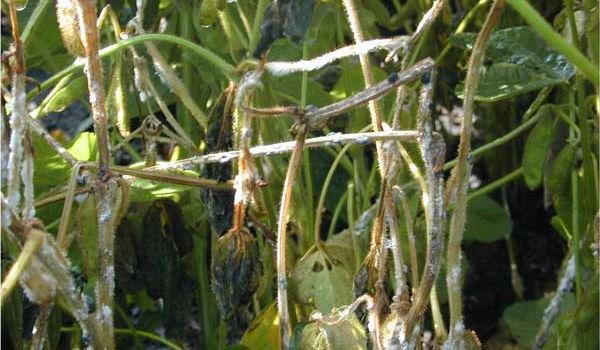Conditions are Ideal for White Mold Growth

We’ve all heard the phrase, “you can’t judge a book by its cover”. This idea can and should be applied to your crops as you scout. You’re familiar with your land, and know that a low spot in the field may be more disease-prone or that a hilltop may be less likely to be productive. But, do you give much consideration to areas of the field where plant growth appears to be good?
Sclerotinia stem rot, or white mold of soybeans, is a scattered issue that may first appear in late July or early August. It is unique in that it usually affects more productive areas of the field with better plant growth vs. the root diseases that normally occur in lower and wetter soils. For this reason, it is difficult to manage white mold. Environmental factors are the most significant cause for infection, with wet weather being a major factor in disease development. Infection of plants varies from year to year and field to field. There is limited variety resistance that I have seen in my years of observing soybeans, which is one reason you do not see a white mold rating on Peterson Farms Seed varieties.
Symptoms
Sclerotia bodies are extremely hardy and are unaffected by weather and soil conditions. In fact, sclerotia from previous years can survive in the soil for over five seasons. White mold usually develops as the result of wet, cool conditions during flowering, and temperatures between 68 degrees and 78 degrees are ideal for spreading the disease. If the soil surface remains wet for at least 10 days, the sclerotia bodies will germinate and develop spores that infect the plants. Symptoms may not be visible for up to 4 weeks after infection. At this time, gray or white lesions form on the stems, and the leaves above the infection point will eventually wilt and die. Pod fill will be set back, and infected plants may not produce any seed. Yield loss can be greater than 15bu/acre in the most severe spots of the field. Soybean standability and seed quality may both be reduced. If the plant is flowering and the environmental conditions are right, the soybean has a chance of being infected.
Management
Managing white mold is difficult once the disease is present in the soil. By the time white mold is visible in the field, it is too late for fungicide application. Preventative measures are the most effective treatments; a fungicide application at the early bloom stage (R2) has shown some benefits in area research trials.
Trials conducted at NDSU’s Research Extension Center near Carrington, ND, have shown limited success with white mold prevention. In these trials, Endura® fungicide is the only treatment that has been significantly successful in managing white mold. The treatment consisted of an application of 5.5oz/ac of Endura®, followed by 4oz/ac of Priaxor®, with a cost about $38/acre. While effective, it is a high input cost to control a problem that may not be present. The trial near Carrington showed a 13bu response to this treatment, so ROI was very positive in this case.
Endura® + Priaxor® would be a good application in fields that have a tight rotation with drybeans, canola, sunflowers, or soybeans, as well as fields with a history of white mold. An application of 6oz/ac of Cobra® has shown mixed results for reducing white mold. Valent claims the Cobra® stimulates the soybean to produce natural defenses to ward off infection of Sclerotinia.
If you’re looking to try a fungicide to prevent white mold this year, consider using one with either a 7 (Endura) or 11 (strobilurins) Site of Action, applied at the early flower stage. This has been the best treatment of recent trial work. Remember, applying fungicide after infection will not cure the plant of white mold.
If you discover white mold on your farm, follow these harvest tips: Harvest healthy fields before harvesting disease-infested fields, if possible, so the combine does not transport sclerotia to other fields. Be sure to thoroughly clean out the combine at the end of the season.
After a cool, wet spring, conditions in our region are ideal for white mold growth. As you scout, remember that “you can’t judge a book by its cover”. Make an effort to monitor all of your fields, and check under the canopy for evidence of white mold. Continue to adapt your practices to prevent potential yield loss. This is especially important if you have a history of white mold on your farm.



